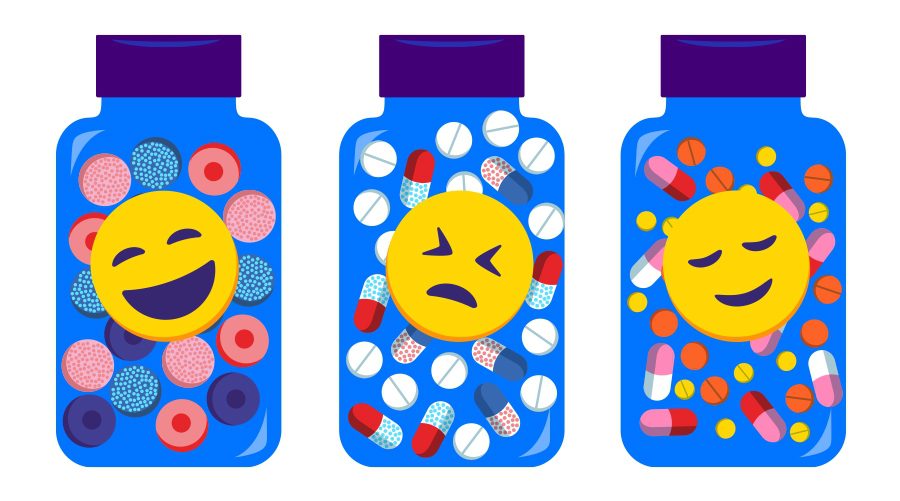Is your brand a painkiller, vitamin or candy?
Answering this simple question is key to prescribing the most effective antidote to meet your customers' needs and ensure the longevity of your business.


Answering this simple question is key to prescribing the most effective antidote to meet your customers' needs and ensure the longevity of your business.


Do you need an injection of creative thinking or a completely new holistic remedy to help your business, brand, customers and colleagues thrive in a challenging new landscape? At D&P, we believe our total brand experience approach can help brands pivot and transform in creative and commercial ways. Whether it’s to reassure existing audiences, attract new values-driven people or to become fit for a new economy, we’re all in this together - and we want to help.
The theory goes that there are three kinds of businesses:
Then there are some businesses who can be all three at different times for their customers and colleagues.
We know from recent and personal experience what “we” do, when in pain, or at the fearful thought of future pain. We buy paracetamol, we stockpile toilet rolls, we add flour and yeast to our baskets, possibly for the first time in years.
In service design, we map out the customer journey to see what’s not working. When we uncover them, these moments are known as pain points. And where there's pain, there's opportunity. Opportunity for innovation, kindness and positive change lies where experientially, there is a gap between need and expectation, where customers are either underserved or being oversold to.
Where is the pain for your customers and colleagues? Pinpoint it and prioritise it.

At D&P we work across a broad range of sectors, brands and cultural regions. We define and design experiences based on the brand’s purpose and the customers’ implicit and explicit needs. This simple and memorable question helps us unlock the brief behind the brief, at the start of any project together.
There has never been a more vital time to cut through the noise, legacy behaviour or ‘business as usual’. By simply, humbly, knowing yourself (or your business’s core purpose), we can all strive to work towards being the answer to your future customers’ needs. [Note that when we say “customer” this is not always a financial transaction, it could be loyalty, goodwill, future consideration or subscribing to your way of thinking].
What’s the problem we’re trying to solve and what’s the most relevant or engaging prescription to remedy it?
Is your brand or service a painkiller, vitamin or candy?
The “painkiller, vitamin, candy” analogy is believed to have been coined by Kevin Fong, a venture capitalist in the Bay area of San Francisco, after seeing endless business plans which praised innovation and features - the how and the what - but infrequently stated the problem it was solving - the why.
Simon Sinek’s global best-selling “start with why” and much-loved TED talk would agree.
At D&P we believe that engaging brands have a clear purpose and express it with their personality, people, process, product and place. And the most engaging brands in the world do these “6Ps” in a unique way that’s impossible to copy, because it’s built into their being, it is founded on their values, their business DNA and is evidenced in all it says and does consistently, yet creatively.
Do you know why your business, service or brand exists? Do your audience know?
It’s a deceptively simple question with an answer that can change depending on where the customer is and at what time.
Think of Instagram – is it a painkiller, a vitamin or a candy to the subscribed follower?
For the small business owner, it’s a marketing painkiller, an empowering and effective marketing tool. For the globally-connected family it’s a nice-to-have vitamin that brings them closer together and fills in the gaps between lengthy video calls. Finally for the meme-aware, dog-obsessed, working-from-home multitasker, it’s pure candy joy and entertainment.
Do you know your target audience well enough, to know who is underserved and in most need of your innovation and experience?

A brand or service can prescribe a mix of remedies, depending on what your measures of success are.
You could argue from the business’s perspective that Instagram was pure candy on launch, with addictive looks and behaviours (metric: users/followers) that turned vitamin-useful (metric: depth of engagement), later acquired by Facebook who sought the painkilling abilities for businesses to advertise and reach wider audiences (metric: return on investment, advertising revenue, click-through conversion).
At the risk of bending this metaphor to breaking point, there are three preventative ways we can help you to define and design engaging brand experiences for future business health.
Be well.
Illustrations by Gemma Dinham

The first ever SXSW London took over Shoreditch this month, offering a wealth of inspiration and insights across tech, business and culture. We share our thinking into how it can return even bigger and better for 2026.

